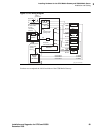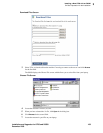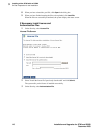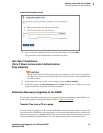
3
Installing a New G700 with an S8300
Before Going to the Customer Site
104 Installation and Upgrades for G700 and S8300
December 2003
Before Going to the Customer Site
The procedures in this section should be completed before going to the customer site or before starting a
remote installation.
Off-site Tasks
Get Planning Forms from the Project Manager
The project manager should provide you with forms that contain all the information needed to prepare for
this installation. The information primarily consists of IP addresses, subnet mask addresses, logins,
passwords, people to contact, the type of system, and equipment you need to install.
Verify that the information provided by the project manager includes all the information requested in
your planning forms.
Tip:
Appendix B, Information Checlists, provides several checklists to help you gather the
installation and upgrade information.
Get the Serial Number of the G700,
if Necessary
For an upgrade of an existing G700, the existing license file can usually be reused. However, if the
customer is adding feature functionality (for example, adding BRI trunks), or if the upgrade is between
major releases (for example, 1.3 to 2.0), you will need the serial number of the G700. To get this number,
ask the customer’s administrator to log in to the S8300 web page and select
View License Status from
the main menu to display the serial number.
For a new installation, you need the serial number of the G700 Media Gateway in order to complete the
creation of the customer’s license file on the rfa.avaya.com web site. To get this number, look for the
serial number sticker on the back of the G700 chassis. If the unit is delivered directly to the customer and
you will not have phone or LAN line access from the customer site to access the rfa.avaya.com web site,
this task will require a preliminary trip to the customer site.
Check FTP Server for Backing up Data
During the installation and upgrade procedures, you will need to back up the system data to an FTP
server. Normally, you will use an FTP server on the customer’s LAN for backups. To do this, you will
need information on how to get to the backup location — login ID and password, and the IP address and
directory path on the FTP server. Check with your project manager or the customer for this information.


















